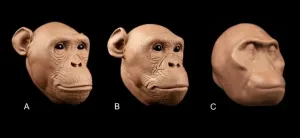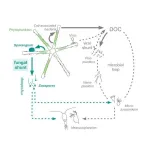SLAS Discovery's June issue on synthetic biology available now
2021-06-04
(Press-News.org) Oak Brook, IL - The June edition of SLAS Discovery features the cover article, "A Perspective on Synthetic Biology in Drug Discovery and Development--Current Impact and Future Opportunities" by Florian David, Ph.D. (Chalmers University of Technology, Gothenburg, Sweden), Andrew M. Davis, Ph.D. (AstraZeneca, Cambridge, England, UK). Michael Gossing, Ph.D., Martin A. Hayes, Ph.D., and Elvira Romero, Ph.D., and Louis H. Scott, Ph.D. (AstraZeneca, Gothenburg, Sweden), and Mark J. Wigglesworth, Ph.D. (AstraZeneca, London, England, UK).
In January 2021, a survey of immunologists, infectious-disease researchers and virologists found that 90% of respondents believe SARS-CoV-2 will become endemic, continuing to circulate in pockets of the global population for years to come. Even as vaccines are becoming more widely available, there are people who either do not respond to the treatment or are not suitable for vaccination. There is a critical need to develop small molecule inhibitors for this pathogen.
The cover article highlights the work of the Drug Discovery Unit at the University of Dundee (Dundee, Scotland, UK) reporting on the development of a high-throughput biochemical assay to assess the impact of small molecules on the methyltransferase activity of SARS-CoV-2 nonstructural protein 14 (nsp14). This enzyme is responsible for the N7-methylation of the cap at the 5' end of viral RNA and is critical in helping coronaviruses evade host defenses. The label-free MS-based assay developed was used to screen a library of 1771 FDA-approved drugs. The chemical hits that were identified may serve as starting points for drug discovery programs aimed at delivering therapeutics for the SARS-CoV-2 virus.
The June issue of SLAS Discovery includes nine articles of original research.
These include:
Development and Validation of High-Content Analysis for Screening HDAC6-Selective Inhibitors
In Vitro Pharmacokinetic/Pharmacodynamic Modeling of HIV Latency Reversal by Novel HDAC Inhibitors Using an Automated Platform
Identification and Kinetic Characterization of Serum- and Glucocorticoid-Regulated Kinase Inhibitors Using a Fluorescence Polarization-Based Assay
Reducing False Positives through the Application of Fluorescence Lifetime Technology: A Comparative Study Using TYK2 Kinase as a Model System
Biochemical and Cellular Profile of NIK Inhibitors with Long Residence Times
A Novel High-Throughput FLIPR Tetra-Based Method for Capturing Highly Confluent Kinetic Data for Structure-Kinetic Relationship Guided Early Drug Discovery
A Multipronged Screening Approach Targeting Inhibition of ETV6 PNT Domain Polymerization
Unbiased High-Throughput Drug Combination Pilot Screening Identifies Synergistic Drug Combinations Effective against Patient-Derived and Drug-Resistant Melanoma Cell Lines
Regenerable Biosensors for Small-Molecule Kinetic Characterization Using SPR
Other articles include:
A Perspective on Synthetic Biology in Drug Discovery and Development--Current Impact and Future Opportunities
Public-Private Partnerships: Compound and Data Sharing in Drug Discovery and Development
A High-Throughput RNA Displacement Assay for Screening SARS-CoV-2 nsp10-nsp16 Complex Toward Developing Therapeutics for COVID-19
Development of a High-Throughput Assay to Identify Inhibitors of ENPP1
Access to June's SLAS Discovery issue is available at https://journals.sagepub.com/toc/jbxb/current. For more information about SLAS and its journals, visit https://www.slas.org/publications/slas-discovery/ Access a "behind the scenes" look at the latest issue with SLAS Discovery Author Insights podcast. Tune in by visiting https://www.buzzsprout.com/1099559.
INFORMATION:
SLAS (Society for Laboratory Automation and Screening) is an international professional society of academic, industry and government life sciences researchers and the developers and providers of laboratory automation technology. The SLAS mission is to bring together researchers in academia, industry and government to advance life sciences discovery and technology via education, knowledge exchange and global community building.
SLAS Discovery: Advancing the Science of Drug Discovery, 2019 Impact Factor 2.195. Editor-in-Chief Robert M. Campbell, Ph.D., Twentyeight-Seven Therapeutics, Boston, MA (USA).
SLAS Technology: Translating Life Sciences Innovation, 2019 Impact Factor 2.174. Editor-in-Chief Edward Kai-Hua Chow, Ph.D., National University of Singapore (Singapore).
ELSE PRESS RELEASES FROM THIS DATE:
2021-06-04
An international subject pool was studied to confirm the effectiveness of a whole food complete vitamin and meal replacement product, IQed. The article, co-authored by Lisa Geng; Francine Hamel, EdD, SLP-CCC; Doreen Lewis, Ph.D., appeared in the peer-reviewed journal, Alternative Therapies (Altern Ther Health Med 2021 Mar;27(2):11-20(.
The findings indicate that the carefully developed nutritional supplement, IQed Smart Nutrition, can help bolster key functions for people with a wide range of prevalent diagnoses including Autism, Apraxia, ...
2021-06-04
Oak Brook, IL - The June edition of SLAS Technology is a Special Issue entitled, "Emerging Trends in 3D Cell Culture: High-Throughput Screening, Disease Modeling and Translational Medicine." Free online access to the articles in this collection is courtesy of Corning Life Sciences, the issue's sponsor.
Precision medicine is becoming an increasingly popular and powerful way to target and treat human diseases. Patient-derived cellular models ushered in high-throughput screenings (HTS) in laboratory automation. While the upkeep and expansion of cells for HTS is predominantly manual, this special issue explores an automated avenue for HTS in research settings that considers the expansion of cells. This design is flexible for research and development ...
2021-06-04
At Boston University, a team of researchers is working to better understand how language and speech is processed in the brain, and how to best rehabilitate people who have lost their ability to communicate due to brain damage caused by a stroke, trauma, or another type of brain injury. This type of language loss is called aphasia, a long-term neurological disorder caused by damage to the part of the brain responsible for language production and processing that impacts over a million people in the US.
"It's a huge problem," says Swathi Kiran, director of BU's Aphasia Research Lab, and College of Health & Rehabilitation Sciences: Sargent College associate dean for research and ...
2021-06-04
The new drug sotorasib reduces tumor size and shows promise in improving survival among patients with lung tumors caused by a specific DNA mutation, according to results of a global phase 2 clinical trial. The drug is designed to shut down the effects of the mutation, which is found in about 13% of patients with lung adenocarcinoma, a common type of non-small-cell lung cancer.
The Food and Drug Administration approved sotorasib May 28 as a targeted therapy for patients with non-small-cell lung cancer whose tumors express a specific mutation -- called ...
2021-06-04
PROVIDENCE, R.I. [Brown University] -- A new study of monsoon rainfall on the Indian subcontinent over the past million years provides vital clues about how the monsoons will respond to future climate change.
The study, published in Science Advances, found that periodic changes in the intensity of monsoon rainfall over the past 900,000 years were associated with fluctuations in atmospheric carbon dioxide (CO2), continental ice volume and moisture import from the southern hemisphere Indian Ocean. The findings bolster climate model predictions that rising CO2 and higher global temperatures will lead to stronger monsoon seasons.
"We show that over the last 900,000 years, higher CO2 levels along with associated changes in ice volume and moisture ...
2021-06-04
Accurate soft tissue measurements are critical when making reconstructions of human ancestors, a new study from the University of Adelaide and Arizona State University has found.
"Reconstructing extinct members of the Hominidae, or hominids, including their facial soft tissue, has become increasingly popular with many approximations of their faces presented in museum exhibitions, popular science publications and at conference presentations worldwide," said lead author PhD student Ryan M. Campbell from the University of Adelaide.
"It is essential that accurate facial soft tissue thickness measurements are used when reconstructing the faces of hominids to reduce the variability exhibited in reconstructions of the same individuals."
Hominids have been readily accepted ...
2021-06-04
A new study shows that substantial amounts of carbon dioxide were released during the last millennium because of crop cultivation on peatlands in the Northern Hemisphere.
Only about half of the carbon released through the conversion of peat to croplands was compensated by continuous carbon absorption in natural northern peatlands.
Peatlands are a type of wetland which store more organic carbon than any other type of land ecosystem in the world.
Due to waterlogged conditions, dead plant materials do not fully decay and carbon accumulates in peatlands over thousands of years.
Therefore, natural peatlands help to cool the climate by capturing carbon dioxide (CO2) from the atmosphere ...
2021-06-04
ABSTRACT #9003
HOUSTON - Results from the Phase II cohort of the CodeBreaK 100 study showed that treatment with the KRAS G12C inhibitor sotorasib achieved a 37.1% objective response rate and 12.5 months median overall survival in previously treated patients with KRAS G12C-mutated non-small cell lung cancer (NSCLC), according to researchers from The University of Texas MD Anderson Cancer Center. The findings were presented today at the 2021 American Society of Clinical Oncology (ASCO) Annual Meeting and published in the New England Journal of Medicine.
Trial results indicated the targeted therapy was safe and tolerable in a heavily pre-treated patient population. The reported findings make sotorasib the first KRAS G12C inhibitor to demonstrate overall survival benefit in a registrational ...
2021-06-04
A research group of the Department of Pharmacy and Biotechnology of the University of Bologna analyzed more than one million SARS-CoV-2 genome sequences. This analysis led to the identification of a new variant that, over the past weeks, has been spreading mostly in Mexico but has also been found in Europe. Their paper published in the Journal of Medical Virology presented the so-called "Mexican variant", whose scientific name is T478K. Like other strains, this presents a mutation in the Spike protein, which allows coronaviruses to attach to and penetrate their targeted cells.
"This variant has been increasingly spreading among people in North America, particularly in Mexico. To date, this variant covers more than 50% of the existing viruses in this area. The ...
2021-06-04
Tiny algae in Earth's oceans and lakes take in sunlight and carbon dioxide and turn them into sugars that sustain the rest of the aquatic food web, gobbling up about as much carbon as all the world's trees and plants combined.
New research shows a crucial piece has been missing from the conventional explanation for what happens between this first "fixing" of CO2 into phytoplankton and its eventual release to the atmosphere or descent to depths where it no longer contributes to global warming. The missing piece? Fungus.
"Basically, carbon moves up the food chain in aquatic environments differently than we commonly think it does," said Anne Dekas, an assistant professor of Earth system science at Stanford University. Dekas is the senior ...
LAST 30 PRESS RELEASES:
[Press-News.org] SLAS Discovery's June issue on synthetic biology available now



